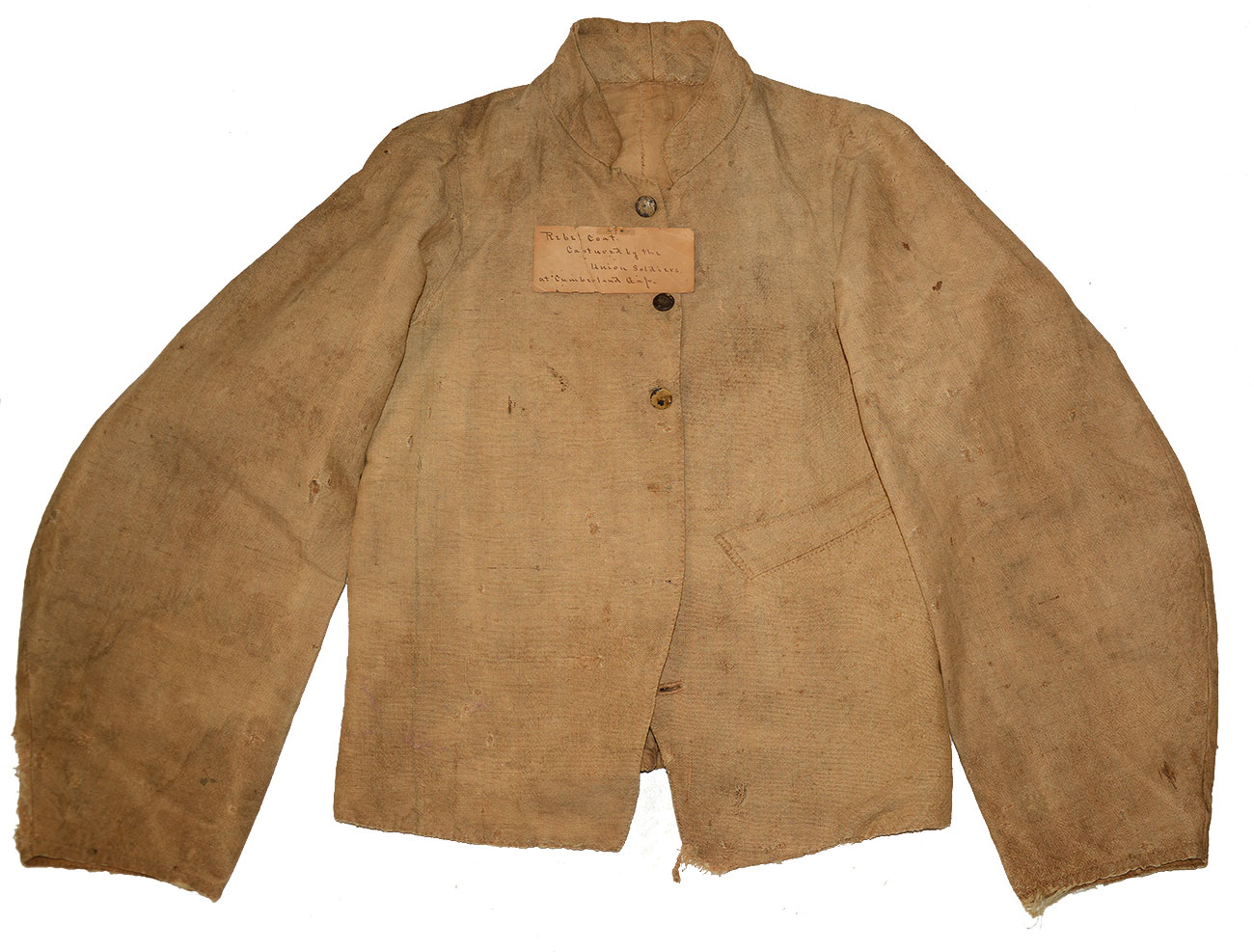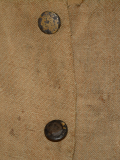site search
online catalog
RARE CONFEDERATE DEPOT SACK COAT: ENLISTEDMAN’S JACKET WITH PERIOD TAG, CAPTURED AT CUMBERLAND GAP

$35,000.00 SOLD
Quantity Available: None
Item Code: 1179-423
This wonderful Confederate jacket is of a very rare type most recently classified as Confederate depot sack coat by Fred Adolphus in 2019. It originally surfaced in the Roseville-Zanesville, OH, area in late 2006 or early 2007 and comes with its original, world-class brown ink tag reading, “Rebel Coat / Captured by the / Union Soldiers / at Cumberland Gap,” as well as reports by respected CS uniform authority Les Jensen (2007) and textile conservation specialist Fonda Thomsen (2008,) both giving it approval. Copies of these reports, along with additional photographs are available to potential purchasers and Adophus’s article, containing photos and comments on this particular jacket and parallels can be accessed online. This jacket was most recently in the collections of the Texas Civil War Museum.
The jacket is tan colored, well qualifying as “butternut,” entirely hand-sewn, with a six-piece body, stand-up collar 1-1/2” tall on the outside of the back seam (made with not interfacing,) and one-piece sleeves with 5-1/2” cuffs and a good billow measuring 8-1/2” at the widest. It was fastened by six buttons, three of which remain and are two-piece iron buttons, with iron shanks, painted in a yellow ochre that now shows very close in color to the jacket. The jacket has a single, exterior pocket on the wearer’s lower left, 6” wide and 8” deep.
The jacket’s exterior fabric has a cotton warp and wool weft. Jensen refers to it as “tabby woven goods.” Thomsen notes it is a type sometimes referred to inaccurately as jean cloth, fustian or shoddy, but does not provide and appropriate term for the fabric. The jacket is lined in the body and sleeves with an unbleached cotton osnaburg, which Jensen notes is a tabby weave. The jacket is completely original, unaltered and untouched with the exception of two of the buttons that had some additional stitching. It shows some wear to the collar, cuffs, and buttonholes, some stains to the lining and exterior, and some scattered moth nips, but nothing egregious. The right cuff has a hole in the exterior cloth about 3 ½” long and 1” wide at its widest running up along the seam (on the back of the sleeve) from the top of the 3/8” cuff seam. A small right triangle is missing from the bottom corner of the wearer’s left lapel, about 1” tall by ½” on the bottom leg. The forward edge of the right cuff shows wear along the very edge for about 4” though extending only up to the seam 1/4” above. Thomsen notes some dark gray staining in the weave of the cloth on the left sleeve, and some brown stains on the sleeve and back. None of these seems particularly noticeable to us and the jacket rates about excellent for a real, issued and worn Confederate enlistedman’s garment.
Jensen noted the coat has something of the look of a sack coat, with the lower buttonhole a good 5-1/2” above the lower edge, but considered the length of the body too short to qualify for that term. He notes five similar Confederate jackets with standing collars, one-piece sleeves, and similar look, but with some differences among them and only one with a solid history, supposedly drawn from the Quartermaster Department in Richmond in 1864, though Jensen cautions it may not have been made there, and although general construction of the jackets seems similar does not think they resemble Richmond products.
Adophus provides nine parallels, along with those shown in period photographs and drawings, placing them among coats produced under the depot system with independent clothing contractors supplementing government workshop production, with some producers supplying military-style sack coats made of domestically produced and dyed fabrics like this one has, and specifically not using imported fabrics that would indicate in-depot workshop construction. He specifically notes the cut of garments is, “loose enough to fit comfortably over the tops of the hips, and stay well-tucked under the soldier’s waist belt and accoutrements,” though still far shorter in the body than their Union counterparts, conserving cloth in the production. These were close enough to jacket patterns that no one at the time made any official distinction, nor did the soldiers, though he notes a September 1861 Confederate Tennessee quartermaster specification that jackets should extend four inches below the waist.
Among the common stylistic elements of the type as noted by Adolphus are bodies, with one exception, ending above the cuff line, like a jacket, but with the longer body giving more flare over the hips. There were also generally fewer buttons than on the jacket and the button placement, ending above the lower edge, often around the navel, “provides the illusion of a longer coat.” Collars were generally standing collars rather than the fall style on civilian and on the Union sack coats. They also generally have a single exterior pocket as does this one. Lastly, they generally have simpler, four-piece bodies, with the six-piece body of this one and the six buttons, rather than four or five, suggesting an early date of production, though he mistakenly identifies the buttons as wood rather than metal from the photographs he worked from.
Adolphus also suggests a western depot origin for the coat on based on its capture at Cumberland Gap, Tennessee, though the phrasing of the note with it, “captured by the Union troops at Cumberland Gap” suggests a larger engagement of some sort and the only one qualifying is the September 9, 1863, capture of the post and garrison after two days of fighting. Earlier occupations of that strategic position by both sides had resulted from simple withdrawals by their opponents. In this case two days of fighting and a siege resulted in a surrender of the garrison, yielding about 2,000 prisoners from Frazer’s 5th Brigade of the Army of the Tennessee, composed of troops from Georgia, North Carolina, Virginia, and cavalry from Tennessee, expanding possible sources for the garment, without pushing too hard Adolphus’s reference to a Tennessee quartermaster cited above.
Letters from the original collector who owned the coat, quoted by both Jensen and Thomsen, indicate the coat was found in a house in the Roseville-Zanesville, Ohio, area, and he postulated it came from a local G.A.R. post. The tag certainly indicates it was on display at some point, most likely brought back by a local veteran, and even wartime displays of captured items at Sanitary Commission fairs and in storefront windows are known. In any case, eight Ohio units in two brigades were involved in the final capture of the strategic gap in September 1863: 86th and 129th, and the 44th, 100th, and 104th; along with the 4th and 7th Cavalry, and the 22nd Ohio Battery. We note the first collector to own it suggested Col. Samuel Gilbert, a Zanesville native, commander of the 44th Ohio and one of the brigades in the battle, as a possible source for the jacket, but it is unclear if he was still connected with Zanesville at that point and a stronger candidate might surface among area G.A.R. veterans.
Regardless of the exact identity of the Union captor, this is a great looking Confederate enlistedman’s jacket of a very specific, scarce pattern with a wonderful period display tag and solid connection to Confederate defense of a strategic position in the Cumberland Mountains providing access to eastern Kentucky, Tennessee and western Virginia. [sr][ph:L]
~~~~~~~~~~~~~~~~~~~~~~~~~~~~~~~~~~~
THIS ITEM, AS WITH ALL OTHER ITEMS AVAILABLE ON OUR WEB SITE,
MAY BE PURCHASED THROUGH OUR LAYAWAY PROGRAM.
CLICK HERE FOR OUR POLICIES AND TERMS.
THANK YOU!
Inquire About RARE CONFEDERATE DEPOT SACK COAT: ENLISTEDMAN’S JACKET WITH PERIOD TAG, CAPTURED AT CUMBERLAND GAP
For inquiries, please email us at [email protected]
Most Popular
Historical Firearms Stolen From The National Civil War Museum In Harrisburg, Pa »
Theft From Gravesite Of Gen. John Reynolds »
Selection Of Unframed Prints By Don Troiani »
Fine Condition Brass Infantry Bugle Insignia »
British Imported, Confederate Used Bayonet »
Scarce New Model 1865 Sharps Still In Percussion Near Factory New »
featured item
CONFEDERATE FIRST NATIONAL FLAG FROM ISLAND NUMBER TEN
This Confederate First National flag has a tight provenance going back to 1935, and before that an oral history as a war souvenir brought back from Island Number Ten by James William McLaughlin, a prominent Cincinnati architect who in 1861 had served… (1179-004). Learn More »
site search
Upcoming Events
May 16 - 18: N-SSA Spring Nationals, Fort Shenandoah, Winchester, VA Learn More »






















